“A structured form of small group problem solving that incorporates the use of heterogeneous teams, maintains individual accountability, promotes positive interdependence, instills group processing, and sharpens social/leadership skills.” – This definition is taken from Babara Millis and reviewed in her IDEA Paper
Spencer Kagan is another influential scholar of Cooperative Learning and his PIES definition is useful in visually identifying important aspects of Cooperative Learning. The "P" in PIES stands for positive interdependence. The "I" is individual accountability and the "E" is equal participation. Here, we have added "equitable" in parentheses to recognize that the term "equal" may fail to represent the diverse ways that each individual may add value to a team. The final "S" in PIES stands for simultaneous interaction.
The active learning modalities in cooperative learning are called “structures”. Our descriptions of structures below provide only highlights but Barbara Millis's books, "Cooperative Learning for Higher Education Faculty" and "Cooperative Learning in Higher Education" go into greater depth.
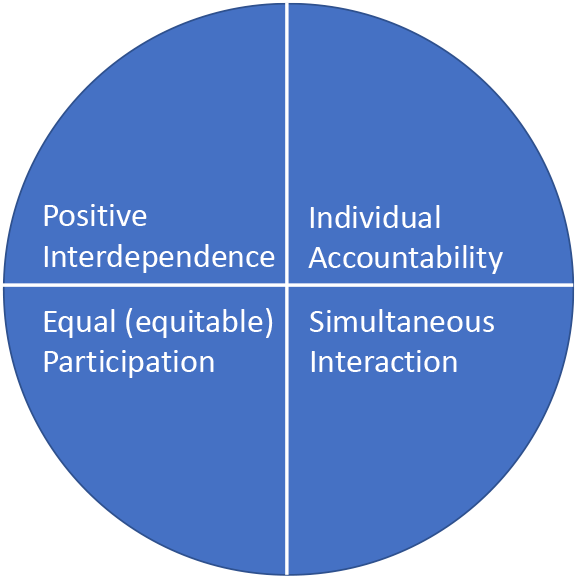
Students write for 1-minute (or a bit longer) in response to a prompt. This is often used to get feedback about a class session.
Students are asked to think privately about a given question or problem before pairing with a neighbor or partner to discuss their answers. Finally, students share out to the entire class.
The instructor poses an open-ended question. The first student listens with minimal prompts while the second student answers the question. After a select amount of time, the students switch. Students then move into groups of 4 and partners share about one another's answers.
The instructor poses an opinion question and asks people to stand in a line based on their response. This can be used to form heterogeneous groups (e.g. #1, 10, 11 and 20 in the line, form a group).
The instructor poses a question that can be answered with a descriptive word or two (e.g. List some skills that employers want their employees to have). Students select 1 team member to write down all of the answers. Give the team a short, set amount of time to generate the list.
The instructor poses an open-ended question. One teammate begins with a piece of paper. That teammate writes down one response and says it aloud. She/he/they then pass the paper to the left and the second and so on. person writes and says a response.
After students have done a brainstorming activity in their teams, select one student from each team to stand up in a line. Each representative than rapidly shares her/his/their answer. Several rotations may be needed.
Students review the list from a brainstorming activity and select a problem they want to solve. They discuss several solutions and settle on one that is worth sharing. These solutions may be shared using 3 stay, 1 stray or other report out structures.
After engaging with content in the form of a mini-lecture or reading, students use their own words/strategies to explain the content to a particular audience (e.g. Explain the concept of matrices to a high school student).
After teams have worked to solve a problem, select 1 teammate who will rotate to the next team. That teammate shares the teams solution and engages in dialogue. Rotate again as many times as desired. The "stray" returns to the home team and the team debriefs that person.
Create a two-column table. On the left column students summarize what the author says; include the authors main points in the order they occur. On the right column students write about their response to the Author (ask questions, share reactions, connect to other/prior learning). In class, share this with a partner.
Each member of a student team is assigned one element of a problem. That member becomes the ‘expert’ on their aspect. This expertise is gained by becoming a temporary member of a new team. In Cooperative Learning, cards are often used to determine these teams. After each student in the temporary team becomes very well-versed in both knowing and teaching their element of the problem, they return to their home team. The team is then equipped to solve the full problem if they wisely use each member’s expertise.
Minute Paper
At the end of a class session or at the end of a class segment, the minute paper enables students to give feedback. Some common prompts for a minute paper are listed below:
-
What is the most important thing you learned today?
-
What questions still remain unanswered?
-
Rate your confidence in your knowledge from today's class on a scale of 1-5.
A minute paper can be done on a provided index card, old scraps of paper or online, it can be done in a chat, on a padlet or using a polling software. Students should have the option to respond anonymously.
Professors or learning assistants can then collect and review the minute papers in order to find themes. These themes can be used to structure a mini response lecture. Alternatively learning assistants could develop an activity to enable review of common questions or misconceptions.
Think-Pair-Share
This active learning modality was developed by Frank Lyman in 1981 and asks students to first think privately about a given question or problem before pairing with a neighbor or partner to discuss their answers. Students can then report out to the entire class or, in large classes, they may be asked to share with the pre-established teams of 4-6 students. The latter variation is often called Think-Pair-Square.
Here are a few tips for structuring successful Think-Pair-Share or Think-Pair-Square learning moments:
-
The best questions are those that require critical thought and do not have one right answer.
-
Be sure to give students 30 seconds to 1-minute to think of (and possibly write down) their response. Do not rush the "Think" part of this activity. Silent thinking is a very important part of active learning.
Three-Step Interview
In this structure, students begin by forming a pair. These pairings can be selected randomly but we suggest that the instructor determine how the pairings are formed, rather than allow students to choose. Ideally students would be paired with someone whom they do not know well.
Next, one of the two students in the pair is desginated as the interviewer. It can work well to give students post-it papers or cards as they enter the room. Particular colors can designate who is the first interviewer. Specify the amount of time during which the students will interview their partners. Set a stop watch and when the time has run out, the interviewer becomes the interviewee. Suggest that the student doing the interview focus on listening without the intent to respond. It is important that this person be able to remember or write down what she/he/they have learned from the person being interviewed.
After both students in the pair have responded to the interview questions, the pair forms a group of four with another pair. Each member of the quad shares about her/his/their partner. Time will be limited so only major highlights will be shared.
The types of questions used in a three-step interview can range from introductory questions that allow students to get to know one another to deep critical thought questions related to course reading or content. Here are just a few examples:
-
What do you percieve as the links between global climate and rising infectious disease?
-
What are the qualities of a productive scientist?
-
What is the relationship between sleep and depression and anxiety?
-
What techniques do you use to enhance the effectiveness of your study hours?
The key to developing good questions for a three-step interview, is to consider areas where it is important that students be able to justify their learning. As they work to explain their answers to a peer, they quickly recognize their missundertandings. Additionally, as professors and learning assistants listen to responses to the questions, they are able to perform a rapid formative assessment of their students' learning. This can guide the depth at which a mini-lecture or review activity addresses discussed concepts. Barbara Millis suggests that every three-step interview have extension questions. These are questions that can by used by pairs that rapidly answer the initial questions.
Value Line
In this active learning modality, students are asked to create a line based on their stance regarding a statement or question. For example, a professor or LA could ask where you ‘stand’ with respect to the statement that climate change is the most important problem facing humanity. Those who strongly agree could be at one end of the line, those who strongly disagree at the opposite end.
Once students are in line, their number in the line can be used to form heterogeneous groups. It may help students to actually number off beginning with 1. The instructor and learning assistant can then help students move into their groups. Below are the suggested groupings for a class of 20:
Group 1: 1, 10, 11 and 20
Group 2: 2, 9, 12 and 19
Group 3: 3, 8, 13 and 18
Group 4: 4, 7, 14 and 17
Group 5: 5, 6, 15 and 16
The same strategy can be used to form groups in larger classes. The instructor or learning assistant finds the midpoint. The lowest and highest numbers as well as the two numbers closes to the midpoint are put into a quad. This is simply repeated for each following group of four.
We suggest that a value line can also be used to deepen student thought by having students explain where they 'stand'. However, this use will require that much attention has been paid to developing classroom climate and creating a 'brave space' within the classroom. A similar approach would involve forming the quad and then asking them to engage in collaborative communication around the issue.
Brainstorming
The instructor or learning assistant poses a question that could have many short answers. For example, "What role does water play within a cell?". Students brainstorm in their teams They can write on a piece of paper, on a white board or glass writing board or using an online tool. One student serves as the recorder and each student in the team quickly shouts out an answer when it is her/his/their turn. The instructor allows a certain amount of time (e.g. 5 minutes) and students simply rotate through their teams as many times as possible.
Roundtable
The instructor or learning assistant asks an open-ended questions. Students use a single piece of paper and a single pen/pencil that gets passed around the table. When students write down their contribution they also say it out loud. This enhances multimodal learning. It also makes it so that everyone around the table is included at each brainstorming step. This activity is meant to flow quickly. It is a quick generation of a list. The question posed may be something like: What are some equity issues that surround the COVID-19 pandemic?
Stand Up and Share
This method can enliven your class because it moves quickly and gets students up!
-
Begin with any brainstorming activity that results in short answers, Roundtable works well.
-
Select one student from a group. It works best if students in a group can be easily identified (e.g. by number) but an instructor or LA could also say, “The student in each team whose birthday is closest to today will stand up and share”.
-
The representatives stand in front of the class and take turns sharing the short answers generated by their groups. More than one rotation may be useful. In fact, rotations can continue until representatives have shared all of their listed responses and have returned to their teams.
Structured Problem Solving
Students are designated teams and there are generally four members in the team. Each of the members is also assigned a role. In Cooperative learning, role assignment is often achieved using playing cards (e.g. all diamonds will have X task). After being given the problem to solve, teams have a limited amount of time. One of the members (e.g. the heart) will be designated to share the teams’ problem solving solutions.
Directed Paraphrasing
After students have engaged in a pre-class reading, watched a lecture or vodcast or engaged in any active learning modality in which they acquired new knowledge, instructors or learning assistants can give students the task of paraphrasing what they have learned. One important aspect of this technique is to thoughtfully select an audience. For example, students might be asked to explain a concept or process to a freshman biology student or to a co-worker in a medical profession.
In Cooperative learning, the paraphrasing is generally done in writing and is always submitted to the instructor or learning assistant. The most important aspect of this process is that students are then given feedback on their paraphrasing. Additionally, instructors are given quick assessment data. Angelo and Cross (1993) suggest a quick sorting exercise in which student responses are placed into one of 4 piles: ”confused”, “minimal”, ”adequate” and “excellent”. The size of piles can allow the instructor to know how well she/he/they have done in facilitating learning on this topic or process.
For online teaching, we suggest accomplishing Directed Paraphrasing using a digital
tool. For example, students can complete a short Poll Everywhere poll or, better yet,
have them do the actual teaching to their suggested audience using a 1-minute recorded
video on their cell phones. Instructors’ piles allowing assessment become virtual
but products produced by students can better ‘live on’ and can even allow students
to ‘go public’ with their responses.
Three Stay, one Stray
Before 3 stay, 1 stray can be accomplished, teams will have needed to complete some type of problem-solving. One teammate is selected (perhaps by card suit) to rotate to other teams. Rotation cycles have to be predetermined because it can become confusing if classes are large. The rotating team member shares the important points from her/his/their team’s problem solving. Members of the team that the ’stray’ is visiting might ask questions. This rotation can continue until the ‘stray’ returns to her/his/their home team. At that point, it is important that the team debrief the ‘stray’ about all that they learned from other visitors.
This can be accomplished in synchronous sessions online using Zoom breakout rooms. The host (instructor or LA) will need to move the ‘strays’ from one breakout room to another.
Double-Entry Journal
Barbara Millis (2010) refers to this as a type of graphic organizer. Students create a double-entry journal after reading a complex piece of literature. They use a piece of paper to draw two columns. The column on the left is filled with a number of critical points made by the author. The column on the right is the learner’s response to the author’s point. The response might include: thoughts evoked, things you would have liked to ask the author, things you would have pushed back on, and connections that you made between this literature and other things you have studied/read.
Double-entry journals can be shared with a peer and can be used as the content for
a think-pair-share. These journals can be used for assessment if they are turned in
(Millis, 2010). However, these journals have metacognitive value even if they are
never submitted.
We have used double-entry journals online very effectively. We stick with the paper
format and then put students into pairs in breakout rooms. We ask them to share one
or two of their paired entries and to look for themes within the pair. We then have
them report back into the large group room.
Jigsaw
While there are now many different interpretations of Jigsaw, the structure was first developed in 1994 by J. Clark. In its original form, it is very effective at allowing learners to see how diverse members of a team can all contribute a meaningful piece to solving a puzzle. It allows them to synergistically find solutions to ill-structured problems.
In order to implement this structure, each student in her/his/their original team is assigned (or receives randomly) an element of the problem. This student then pairs with students from other teams who have recieved the same task. Thus, each student begins in a group with homogenous problem-solvers. Once these groups have gleaned enough expertise in their aspect, everyone returns to their home team. Students' home teams now have the collective expertise to solve a bigger problem if they aptly draw on each one of their experts.
Resources and References
Clark, J. (1994). "Pieces of the Puzzle: The Jigsaw Method." In S. Sharan (Ed.), Handbook of Cooperative Learning Methods. (pp. 34-50). Westport, CT: Greenwood Press.
Kagan, S. (1989). Cooperative Learning Resources for Teachers. San Juan Capistrano, CA: Resources for Teachers, Inc.
Kagan, S. (1992). Cooperative Learning. San Juan Capistrano, CA: Resources for Teachers, Inc.
Millis, B. J. (1998). Cooperative Learning for Higher Education Faculty. Westport, CT: Oryx.
Millis, B. J. (2010). Cooperative Learning in Higher Education. Sterling, VA: Stylus.

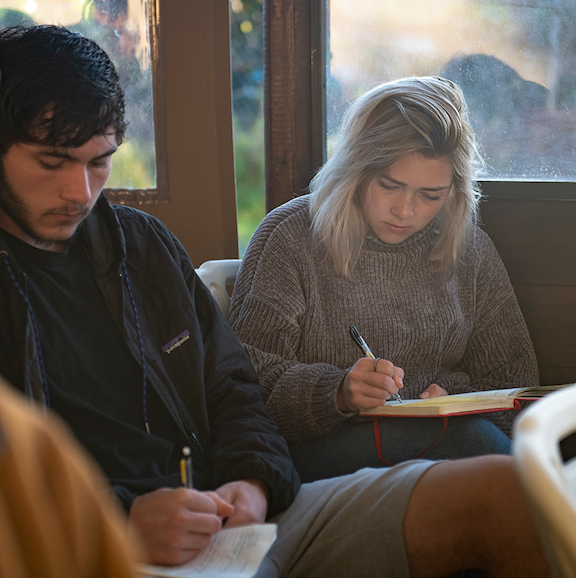 Minute Paper
Minute Paper Think-Pair-Share
Think-Pair-Share The 3-step Interview
The 3-step Interview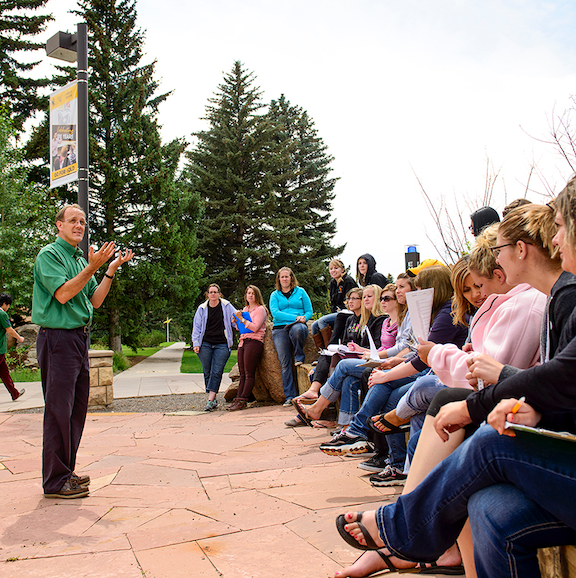 Value Line
Value Line Brainstorming
Brainstorming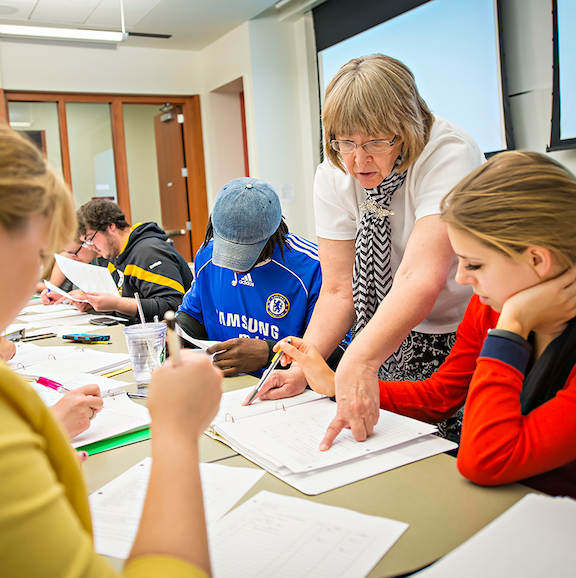 Roundtable
Roundtable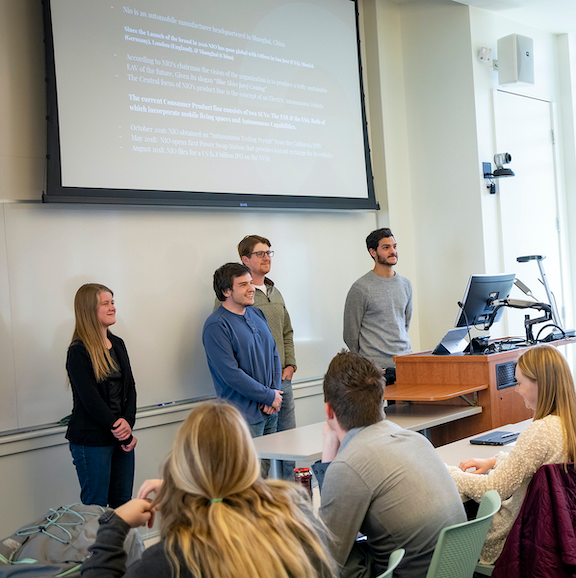 Stand Up and Share
Stand Up and Share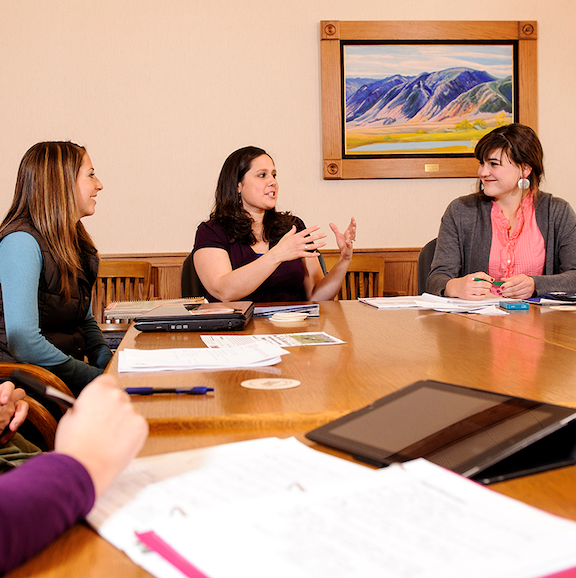 Structured Problem Solving
Structured Problem Solving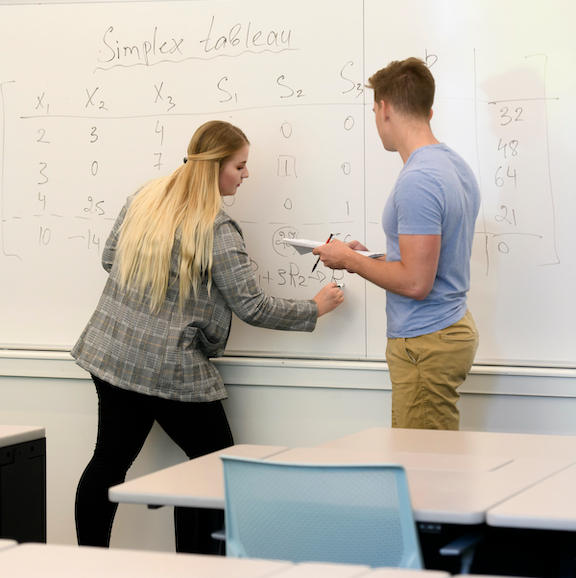 Directed Paraphrasing
Directed Paraphrasing 3 Stay, 1 Stray
3 Stay, 1 Stray Double Entry Journal
Double Entry Journal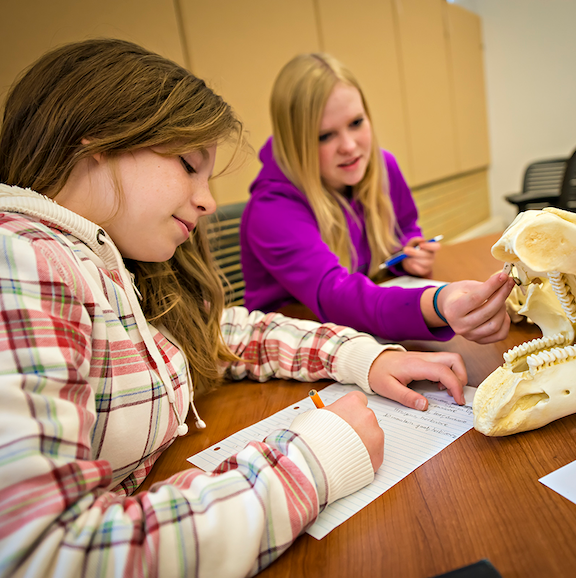 Jigsaw
Jigsaw